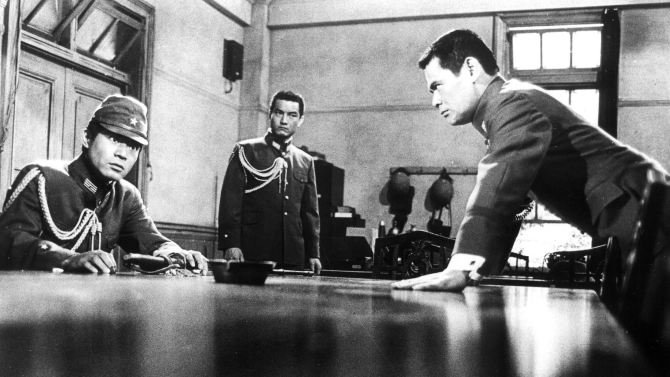AN IMPERFECT BUT CAPTIVATING LOOK AT THE FINAL DAYS OF WWII: JAPAN’S LONGEST DAY
JAPAN’S LONGEST DAY

Pros: Fascinating from a historical perspective; strong acting and directorial style
Cons: Introduces literally hundreds of characters, making it difficult to follow the unfolding storyline
Released to mark the 35th anniversary of the famed Toho Studios, 1967’s Japan’s Longest Day (a.k.a. Nihon no ichiban nagai hi) details the events from late July 1945 until the official Japanese surrender on August 15 of that year. The story begins just before the dropping of the Hiroshima bomb, as Japanese bureaucrats argue about whether they should agree to the demands of the Pottsdam Declaration, which laid out conditions for an unconditional surrender. The deployment of “the bomb” has little effect on the tone of these arguments, but while the politicians continue to bicker over wording in the Declaration which suggests Japan would be “subject to” the command of the Allies, Nagasaki is destroyed, prompting Japanese Emperor Hirohito to step in and declare that he wants to end the war as quickly as possible. Many Japanese find unconditional surrender to be an unacceptable, dishonorable way to exit the war – the Declaration establishes Japan as a “subordinate” nation, and most of the country’s military leaders prefer to fight to the last man – a situation which would likely lead to an incredibly costly American and Soviet invasion of the home islands. Disagreeing with the Emperor however is simply not an option, so even the most reluctant of the military leaders finally accepts the Allies’s terms.

All of the above action, presented in an almost documentary-like manner replete with actual wartime footage and a narrator who explains and provides context to the events, takes place in the first twenty or so minutes of this 167-minute film – the opening titles only show up around the twenty-one minute mark. This might seem strange since it would appear that the main conflict in the story has been resolved with Hirohito’s explanation that he wants his military leadership to agree to surrender. In truth, writer Shinobu Hashimoto’s script (from a story by Soichi Oya) is just getting started, since it’s at this point that Japan’s Longest Day truly gets into its groove, presenting an incredibly detailed, chronological timeline of the events of August 14th and 15th, 1945. As Hirohito records a speech to be broadcast over the radio, telling his nation that he has agreed to surrender, a group of lower-ranking military men and a rogue civilian military battalion choose to march in anger against the Prime Minister and the Emperor himself. It’s the LP recording of the surrender address itself that the rebelling military men are most interested in capturing since they can effectively prolong the war by ensuring that the speech isn’t broadcast.
 Interestingly, though Emperor Hirohito (pictured here) figures prominently in the film, the audience never sees his face and he exists as an almost mystical figure.
Interestingly, though Emperor Hirohito (pictured here) figures prominently in the film, the audience never sees his face and he exists as an almost mystical figure.
Given the lengthy running time, it might not be surprising that Japan’s Longest Day is very talky – particularly during its first half. There’s precious little of what most viewers would consider action during this opening section, which presents a very dramatic portrait of a proud nation in severe pain as it comes to terms with its first major military defeat. Though the prolonged dialogue scenes only reinforce my belief that the film would have a limited audience, with those interested in Japanese history or World War II perhaps having the most to gain by watching it, these moments are nonetheless fascinating to watch from an American perspective. Until very recently, there’s been almost no effort made to present the “other side” of the World War II story: the war is often (still) viewed as an “US versus them” affair, with the Japanese clearly being the “bad guys.” Japan’s Longest Day obviously shows a much different side of the war, but also is rather eye-opening since it shows happens when an ultra-nationalistic country is put in its place so to speak after an extended, far-reaching conflict. One can only imagine what would happen in the United States should it face a similar situation.
 Though it’s long and slow-going at first, the film gets plenty tense down the stretch.
Though it’s long and slow-going at first, the film gets plenty tense down the stretch.
Around the halfway point, just as a narrator explains that only half of Japan’s longest day had elapsed, the film makes a sudden turn into more action-oriented territory. Following a moment pulled straight out of ultra-violent samurai cinema, momentum in the film slowly starts to build and dramatic tension gradually increases, reaching a literal fever pitch by the conclusion. Honestly, I was a bit surprised by this abrupt shift in mood: while captivating in its own way, Japan’s Longest Day seemed all-too willing to simply continue on with its dialogue-heavy presentation. The violent action that eventually turns up is made all the more thrilling simply due to the fact that a viewer who stuck with it had probably grown accustomed to the film’s (up to that point) languishing pace.
 Outstanding shot composition is one of the best things about the movie.
Outstanding shot composition is one of the best things about the movie.
Director Kihachi Okamoto (who was primarily known before this film for samurai pictures such as Samurai Assassin, , and Kill!) does a masterful job of juggling concurrent events . Often, footage showing the most mundane of tasks (discussions about the exact wording of the surrender address that the Emperor will deliver, for instance ) are juxtaposed against scenes of violent struggle taking place in other locations at the same time. The editing work here is really slick, obviously designed for maximum impact, and I especially appreciated the varied choice of camera angles and perspectives as well as the framing in those shots. Directing cinematographer Hiroshi Murai, Okamoto is able to create numerous striking moments: all the hyper-violent scenes are quite shocking in the way they’re related to the camera, but the way Okamoto is able to express the feelings of his characters without dialogue is equally impressive. The film frequently alternates between tight close-ups showing the pained expressions on the actors’s faces and long shots which establish the ways in which their characters are drifting apart ideologically, and I especially liked a scene in which the grief-stricken Emperor is shown clutching a handkerchief in his hand in the foreground while the bitter Minister of War sits stoically in the background.
 A statue-like Toshiro Mifune as the Japanese War Minister.
A statue-like Toshiro Mifune as the Japanese War Minister.
Consistent with American-made war epics like The Longest Day, Battle of the Bulge, or Tora! Tora! Tora! to name but a few, Japan’s Longest Day is an all-star film if there ever was one. Virtually every actor I’ve ever seen in a Toho sci-fi flick (of which the Godzilla films are the most well known) shows up here, and it was a treat for me to see what they could do with quality material. That being said, it’s Toshiro Mifune, never a player in a Toho monster mash, who appears as the obvious main character, playing Minister of War, General Korechika Anami. Mifune says more with just his eyes than many actors could in pages of dialogue, but later in the film, he also handles a moving speech about how the young people in Japan have to carry on after the war, working to improve the nation. His final scene in the picture is absolutely stunning, complimented by one of Okamoto’s best directorial flourishes. In a smaller role, Takashi Shimura is his usual, stately self playing Information Bureau Director Hiroshi Shimomura, but it’s Toshio Kurosawa who arguably turns in the most genuinely memorable performance, playing a major who decides to take matters into his own hands in an effort to prolong the war and achieve a “glorious” final battle. Generally, I found the acting in this film to be very strong and full of an appropriate level of both anguish and fervor.
 Many regulars from Toho’s sci-fi flicks turn up here, and do a surprisingly good job tackling more dramatic and serious material.
Many regulars from Toho’s sci-fi flicks turn up here, and do a surprisingly good job tackling more dramatic and serious material.
Finishing up with a batch of hard-hitting and absolutely astounding stats (some 3,000,000 wartime casualties) and a cautionary statement about how Japan must never experience another 24 hours like the one depicted in the film, Japan’s Longest Day wound up being quite a different film than I would have expected. In all honesty, many American viewers would have no interest in watching this black-and-white, subtitled foreign film in the first place, but the fact that so many characters (identified through use of onscreen text) are thrown at the viewer makes it very difficult to keep track of the ongoing action. At a certain point, I fully expected this to be a sort of endurance test to watch, with strong acting but little action; imagine my surprise then when director Okamoto made sure it went off with a bang during its back half. Confusing though the narrative may be, the observant non-Japanese viewer gets enough of the gist of what’s happening to follow the unfolding events, and in terms of its historical value, I’d have to call this picture important. It definitely provides insight into a time and place that’s not-often (if ever) discussed in America, and I would certainly recommend this challenging but entirely worthwhile film to patient viewers willing to stick with it.

5/10 : Just when you think this movie’s going to be all talk, it lets loose with some blood-spurting violence.
0/10 : No profanity, lots of hard-hitting dialogue.
0/10 : Nada.
3/10 : Will undoubtedly impress history buffs, but many will be turned off by an incredibly talky first half and a story that’s difficult to get a handle on.
“You’re still thinking in terms of success or failure…will it preserve our nation or destroy it?”


















